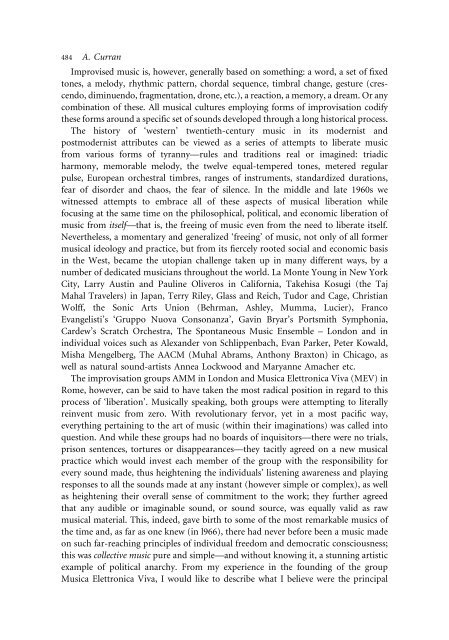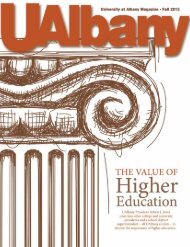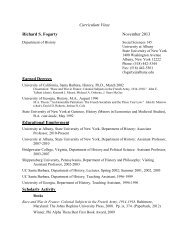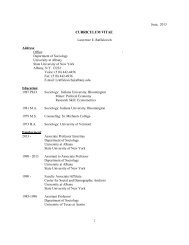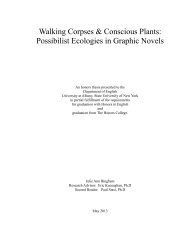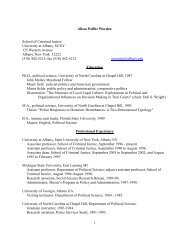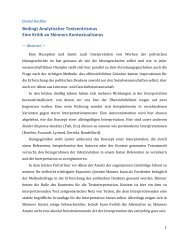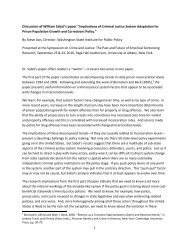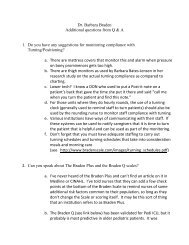Alvin Curran, "On Spontaneous Music" - University at Albany
Alvin Curran, "On Spontaneous Music" - University at Albany
Alvin Curran, "On Spontaneous Music" - University at Albany
You also want an ePaper? Increase the reach of your titles
YUMPU automatically turns print PDFs into web optimized ePapers that Google loves.
484 A. <strong>Curran</strong><br />
Improvised music is, however, generally based on something: a word, a set of fixed<br />
tones, a melody, rhythmic p<strong>at</strong>tern, chordal sequence, timbral change, gesture (crescendo,<br />
diminuendo, fragment<strong>at</strong>ion, drone, etc.), a reaction, a memory, a dream. Or any<br />
combin<strong>at</strong>ion of these. All musical cultures employing forms of improvis<strong>at</strong>ion codify<br />
these forms around a specific set of sounds developed through a long historical process.<br />
The history of ‘western’ twentieth-century music in its modernist and<br />
postmodernist <strong>at</strong>tributes can be viewed as a series of <strong>at</strong>tempts to liber<strong>at</strong>e music<br />
from various forms of tyranny—rules and traditions real or imagined: triadic<br />
harmony, memorable melody, the twelve equal-tempered tones, metered regular<br />
pulse, European orchestral timbres, ranges of instruments, standardized dur<strong>at</strong>ions,<br />
fear of disorder and chaos, the fear of silence. In the middle and l<strong>at</strong>e 1960s we<br />
witnessed <strong>at</strong>tempts to embrace all of these aspects of musical liber<strong>at</strong>ion while<br />
focusing <strong>at</strong> the same time on the philosophical, political, and economic liber<strong>at</strong>ion of<br />
music from itself—th<strong>at</strong> is, the freeing of music even from the need to liber<strong>at</strong>e itself.<br />
Nevertheless, a momentary and generalized ‘freeing’ of music, not only of all former<br />
musical ideology and practice, but from its fiercely rooted social and economic basis<br />
in the West, became the utopian challenge taken up in many different ways, by a<br />
number of dedic<strong>at</strong>ed musicians throughout the world. La Monte Young in New York<br />
City, Larry Austin and Pauline Oliveros in California, Takehisa Kosugi (the Taj<br />
Mahal Travelers) in Japan, Terry Riley, Glass and Reich, Tudor and Cage, Christian<br />
Wolff, the Sonic Arts Union (Behrman, Ashley, Mumma, Lucier), Franco<br />
Evangelisti’s ‘Gruppo Nuova Consonanza’, Gavin Bryar’s Portsmith Symphonia,<br />
Cardew’s Scr<strong>at</strong>ch Orchestra, The <strong>Spontaneous</strong> Music Ensemble – London and in<br />
individual voices such as Alexander von Schlippenbach, Evan Parker, Peter Kowald,<br />
Misha Mengelberg, The AACM (Muhal Abrams, Anthony Braxton) in Chicago, as<br />
well as n<strong>at</strong>ural sound-artists Annea Lockwood and Maryanne Amacher etc.<br />
The improvis<strong>at</strong>ion groups AMM in London and Musica Elettronica Viva (MEV) in<br />
Rome, however, can be said to have taken the most radical position in regard to this<br />
process of ‘liber<strong>at</strong>ion’. Musically speaking, both groups were <strong>at</strong>tempting to literally<br />
reinvent music from zero. With revolutionary fervor, yet in a most pacific way,<br />
everything pertaining to the art of music (within their imagin<strong>at</strong>ions) was called into<br />
question. And while these groups had no boards of inquisitors—there were no trials,<br />
prison sentences, tortures or disappearances—they tacitly agreed on a new musical<br />
practice which would invest each member of the group with the responsibility for<br />
every sound made, thus heightening the individuals’ listening awareness and playing<br />
responses to all the sounds made <strong>at</strong> any instant (however simple or complex), as well<br />
as heightening their overall sense of commitment to the work; they further agreed<br />
th<strong>at</strong> any audible or imaginable sound, or sound source, was equally valid as raw<br />
musical m<strong>at</strong>erial. This, indeed, gave birth to some of the most remarkable musics of<br />
the time and, as far as one knew (in l966), there had never before been a music made<br />
on such far-reaching principles of individual freedom and democr<strong>at</strong>ic consciousness;<br />
this was collective music pure and simple—and without knowing it, a stunning artistic<br />
example of political anarchy. From my experience in the founding of the group<br />
Musica Elettronica Viva, I would like to describe wh<strong>at</strong> I believe were the principal


